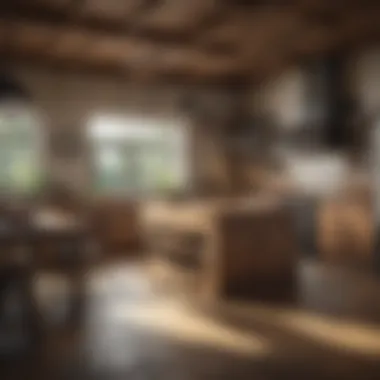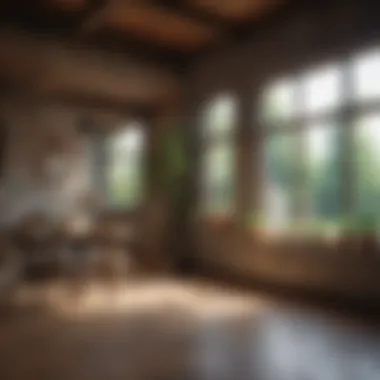Revitalizing Your Old Farmhouse: A Renovation Guide


Intro
Renovating an old farmhouse is not merely a task; it is a journey that intertwines history with contemporary needs. This guide is structured to navigate through this multifaceted process. It discusses essential elements such as maintaining the historical integrity while integrating necessary modern amenities. Homeowners often face challenges in preserving the original charm of their properties amidst the urge for modernization. Understanding these nuances will provide clarity and direction.
A keen awareness of design inspirations, alongside a solid plan for maintenance, becomes imperative to achieving a successful renovation. Homeowners, interior design enthusiasts, and enthusiasts alike will find value in the insights and strategies outlined in this article. Each section aims to address the relevant considerations that can help transform an aging structure into a vibrant and livable space while paying homage to its roots.
Here, we will explore design inspirations that capture the essence of the rustic charm and the practicalities of upkeep that are crucial for sustaining the rejuvenated farmhouse.
Design Inspirations
Design choices in a farmhouse renovation serve as a vessel for personal expression while echoing the building's storied past. It is vital to select elements that resonate with both contemporary sensibilities and historical significance.
Trending Styles
In today’s market, several styles prevail among homeowners looking to renovate old farmhouses. Here are some popular trends:
- Modern Farmhouse: Characterized by a blend of traditional and contemporary elements, this style often incorporates sleek lines, open spaces, and a neutral palette. The focus is on functionality while keeping the rustic feel.
- Industrial Chic: This style embraces raw materials and exposed structures. Incorporating metal accents, barn doors, and reclaimed wood can create an interesting contrast to traditional designs.
- Shabby Chic: This style thrives on vintage charm. It uses soft colors, floral patterns, and distressed finishes to evoke a sense of nostalgia. Items should feel curated and collected over time, rather than simply decorated.
Choosing the right style hinges on a deep understanding of the farmhouse's inherent character, so it is wise to remain attentive to existing features when making decisions.
Color Palettes
The selection of colors plays a critical role in defining the atmosphere of the renovated farmhouse. Some common palettes for consideration include:
- Earthy Tones: Shades like warm browns, greens, and soft taupes create a natural vibe that connects the indoors with the surrounding landscape.
- Pastels: Soft blues, blush, and mint can enhance the airy feel of spaces while maintaining a rustic appeal.
- Monochrome Schemes: A simple black, white, and gray palette can highlight the architectural features without overwhelming the existing aesthetics.
Careful thought on color scheme influences not just aesthetics, but also impacts mood and functionality in various spaces throughout the farmhouse.
Maintenance and Upkeep
Sustaining an old farmhouse demands ongoing attention and effort. It is crucial to develop a consistent maintenance plan, which ensures the home’s longevity and preserves its beauty.
Seasonal Maintenance Checklist
To aid in upkeep, consider creating a seasonal checklist that encompasses tasks specific to climate and local conditions:
- Spring: Inspect roofs, clean gutters, check for leaks, and tend to gardens.
- Summer: Monitor air conditioning systems, paint touch-ups, and inspect wooden structures for pests.
- Autumn: Clean the chimney, winterize the property, and check insulation and heating systems.
- Winter: Look for drafts, maintain heating systems, verify snow removal around foundations.
Regular attention to these details can prevent larger issues from arising in the future.
Cleaning and Organization Tips
Maintaining cleanliness and organization in a renovated farmhouse combines design with practical strategies:
- Use natural cleaning products to maintain hygiene without compromising indoor air quality.
- Establish a designated spot for frequently used items, reducing clutter and enhancing flow within spaces.
- Create a routine that includes daily tidying and deeper weekly cleaning sessions.
The overall functionality of the farmhouse will greatly depend on how well it is organized and cleaned.
A successful renovation is not solely about aesthetics; it also encompasses the practicalities of upkeep, ensuring that the charm of the old farmhouse endures for generations to come.
By considering design inspirations and establishing a thorough maintenance plan, homeowners can realize their vision while respecting the integrity of their historic homes. The path to rejuvenating an old farmhouse is long but rewarding, full of potential for heartwarming memories and beautiful experiences.
Understanding the Appeal of Old Farmhouses
Renovating an old farmhouse offers a unique opportunity for homeowners to connect with history while also creating a livable space that meets modern standards. The charm and character found in these properties often set them apart from contemporary designs. The appeal of old farmhouses lies not only in their aesthetic allure but also their historical significance and architectural features.
Historical Significance
Old farmhouses are often rich in history. Many date back to periods of agricultural expansion, serving as homes for families who worked the land. Each farmhouse tells a story, reflecting the culture and values of its time. When renovating, understanding this history becomes crucial. Some homeowners may discover that their farmhouse is part of a heritage site. Renovating such homes necessitates a respect for these origins.
Preserving elements from the past allows the homeowner to maintain a connection to that history. It can involve simple actions, like restoring original wood paneling or preserving antique windows. Homeowners should conduct thorough research. This gives insights into the structure’s past and helps to identify elements worth preserving.
Architectural Features
The architectural features of old farmhouses often offer a stark contrast to modern buildings. One notable aspect is the craftsmanship involved. Many farmhouses display intricate woodwork, unique moldings, and handcrafted details that are rarely seen in newer constructions. These features not only enhance the aesthetic appeal but also offer functional benefits such as durability.
Another important architectural feature is the layout. Old farmhouses typically have a more functional and welcoming design. For example, large, open spaces like dining areas and kitchens foster social interaction. This can be a strong selling point for families or individuals who value community and togetherness.
When planning renovations, consider these aspects carefully. Retaining the farmhouse's unique architectural style can elevate the overall charm of the property. Understanding the visual and functional strengths of these features helps in making informed choices.
"The beauty of an old farmhouse lies in its imperfections and stories held within its walls. Each crack and creak speaks volumes of the past."
In summary, appreciating the appeal of an old farmhouse involves understanding its historical significance and recognizing the craftsmanship in its architectural features. This combination allows for a renovation that honors the past while adapting to present needs.


Pre-Renovation Considerations
Before embarking on the journey of renovating an old farmhouse, several pre-renovation considerations must be taken into account. These considerations are essential for ensuring a successful renovation that respects the history of the structure while also meeting modern-day functional needs. It involves careful planning and evaluation of various factors that can impact the overall outcome of the project. Addressing these key elements early on can save time, money, and heartache down the line.
Assessing Structural Integrity
Assessing the structural integrity of the farmhouse is one of the most critical steps. This assessment identifies the existing condition of the property and its components. It often involves looking at the foundation, roof, and load-bearing walls. A weak foundation can lead to severe problems later, so it is crucial to check for any signs of cracks or shifts. Roofs may show signs of wear, leaks, or sagging that could necessitate repair or replacement.
Engaging a qualified inspector is advisable to gain an in-depth understanding of these issues. The inspector can provide a detailed report, highlighting areas that need attention. Addressing any structural problems early saves money in the long run and prevents scope creep during the renovation process. Often, fixing fundamental issues not only preserves the integrity of the farmhouse but also enhances its value.
Identifying Historical Restrictions
Renovating an old farmhouse often comes with historical restrictions. Many farmhouses may be classified as historic properties and, as such, may have specific guidelines that dictate how they can be altered. These regulations can come from local, state, or federal levels and may require permits for certain aspects of the renovation. Not adhering to these restrictions can lead to complications, including legal repercussions or mandatory undoing of work that has been completed.
Researching a property's historical status is a smart move. This can include checking local archives, contacting historical societies, or consulting with professionals familiar with these matters. Always consider that some original features might be worthy of preservation, such as antique doors, windows, or woodwork. Not only does this respect the home's history, but it also contributes to the overall charm and character of the renovated space.
Setting a Budget
Setting a budget for the renovation is an essential step that cannot be overlooked. A well-planned budget serves as a roadmap for the entire project. This budget should encompass all aspects, including demolition, construction materials, labor, and furnishings. It is wise to allocate contingency funds, typically around 10%-20% of the original budget, to handle unexpected expenses that may arise during the project.
When estimating costs, consider obtaining multiple quotes from contractors. Doing so offers a clearer picture of the market rate and can result in savings. Furthermore, listing priorities can help when decisions need to be made about where to spend and where to save. Perhaps upgrading the kitchen is most important, so money may be diverted from less critical areas. Creating a flexible yet clear budget framework is critical in making educated choices throughout the renovation journey.
Designing Your Vision
Designing your vision is a crucial step in the renovation of an old farmhouse. This phase allows homeowners to articulate their goals while balancing a respect for the property’s historical integrity. It is essential to envision how the space will function while maintaining its charm. This concept encompasses not only aesthetic decisions but also practical considerations that will lead to a harmonious blend of the old and new.
Preserving Original Elements
Preserving original elements is vital when renovating an old farmhouse. These features, such as wood beams, original flooring, and vintage windows, tell a story. They add character and authenticity to the space. Carefully maintaining these items can enhance the farmhouse's overall aesthetic while also increasing its value.
Homeowners should start with an inventory of existing features. Identifying key elements that must be preserved creates a stronger foundation for the renovation. For instance, if a rustic stone fireplace or handmade cabinetry exists, these should influence the design choices made throughout the renovation.
Benefits of preserving original elements include:
- Cultural heritage: Keeps the historical context alive.
- Increased value: Authentic features often attract buyers and appraisers.
- Unique character: Each element adds uniqueness that can’t be replicated.
It is also wise to invest in restoration services if needed. Skilled craftsmen can maintain or restore original parts that may have worn over time. Using the right techniques and materials can ensure that these priceless pieces stand the test of time.
Incorporating Modern Amenities
While maintaining the farmhouse's original charm is important, incorporating modern amenities cannot be overlooked. Modern facilities enhance functionality and comfort. Finding a way to integrate these amenities seamlessly can improve overall appeal without detracting from the farmhouse's character.
When considering modern upgrades, focus on practical aspects such as:
- Heating and cooling systems: These should blend with the farmhouse's structure without disrupting visual aesthetics.
- Kitchen appliances: Choose energy-efficient options that fit the style of the home. Retro or vintage-style appliances can modernize the kitchen without losing its rustic feel.
- Bathroom fixtures: Upgrade plumbing while keeping layout changes minimal to respect the original design.
It’s important to balance the old with the new. Don’t simply replace items; consider how they can coexist. For example, using reclaimed wood for cabinetry can add a modern touch while staying true to the farmhouse roots.
By thoughtfully designing your vision and considering both original elements and modern comforts, homeowners can create a space that honors the past while preparing for the future.
"Design is not just what it looks like and feels like. Design is how it works."
– Steve Jobs
This approach will lead to a renovation that fulfills both practical needs and aesthetic desires, ensuring the old farmhouse remains both a functional family home and a cherished piece of history.
The Renovation Process
Renovating an old farmhouse requires careful planning and execution. This process is crucial as it addresses both the aesthetic and structural aspects of the property. Engaging in a renovation can enhance the value of the home while also providing the owners with a space that meets their modern needs. By understanding the various steps involved, homeowners can navigate the complexities of renovation with greater confidence and effectiveness.
Planning and Scheduling
Effective planning is fundamental in any renovation project. It sets the foundation for what is to come. Initially, homeowners should define their goals and objectives. This might involve determining which areas need renovation and what budget constraints exist. Having a clear vision helps in making informed decisions throughout the project.
A detailed schedule is equally important. A well-structured agenda will include timelines for each stage of the renovation. Here are some key elements to consider in your planning:
- Timeline Creation: Outline when each part of the renovation will occur. This helps in keeping the project on track.
- Milestones: Set specific milestones to track progress. Celebrating small wins can help maintain motivation.
- Flexibility: Allow for adjustments in the timeline. Unexpected issues may arise, and it is wise to have buffer time for such instances.
Scheduling can also affect the availability of materials and contractors. It is advisable to order materials well in advance to avoid delays. Generally, creating a timeline promotes organization and ensures that efforts are put forth efficiently.
Hiring Contractors vs. DIY
A critical decision in the renovation process is whether to hire contractors or attempt a do-it-yourself approach. Each option has its distinct advantages and disadvantages, which may influence your choice based on budget, skill level, and the scope of work.
Hiring Contractors


When hiring contractors, the primary benefits include:
- Expertise: Contractors possess the skills and experience necessary to complete complex tasks. Their knowledge can save time and reduce mistakes.
- Time Efficiency: Professionals can work on renovations more quickly due to their experience and access to tools.
- Regulatory Compliance: Contractors are often familiar with building codes and local regulations, which minimizes legal risks.
However, this option can be costly. Homeowners should vet contractors thoroughly, checking references and past work to ensure quality.
DIY
On the other hand, engaging in DIY renovations can be rewarding and cost-effective. The benefits include:
- Cost Savings: Performing work yourself can significantly reduce labor costs.
- Personal Satisfaction: Completing projects can create a sense of accomplishment and personalize the home to your taste.
- Learning Experience: DIY allows you to develop new skills that may be beneficial for future projects.
Although DIY can be appealing, it requires a realistic understanding of one’s abilities. Missteps in major renovations can lead to costly errors. Therefore, homeowners should carefully assess their skill levels and the demands of each project before deciding to proceed on their own.
Key Areas of Renovation
Renovating an old farmhouse involves a multitude of considerations, especially focusing on key areas that are critical for both functionality and aesthetics. Selecting the right areas to prioritize ensures that the renovation meets contemporary living standards while respecting the farmhouse's historical essence. Each key area can significantly impact the overall value and comfort of the home. Here are some important considerations for each area:
Roofing and Exterior
The roof is not only a defining characteristic of the farmhouse's profile but essential for protection. A thorough inspection can reveal issues like leaks, decay, or structural concerns that compromise safety. Replacing or repairing the roof can enhance the home’s curb appeal, improve energy efficiency, and prevent future costly damages. Consider materials that align with the farmhouse's architectural style, such as slate or metal roofing, for both durability and visual appeal.
Exterior updates should address siding and windows as well. Restoring original materials can maintain character, whereas modern options can enhance insulation. Pay attention to the inclusion of period-appropriate details that reflect the history of the home.
Kitchen Updates
The kitchen often serves as the heart of the home. Many homeowners focus on this area to blend modern convenience with rustic charm. Updating appliances for energy efficiency is paramount. Integrating vintage-inspired fixtures can align well with the farmhouse aesthetic.
Open layouts are popular for entertaining, making it essential to assess the space. If the layout allows, merging kitchen and dining areas can create warmth and sociability. Countertops, cabinetry, and backsplashes can be selected to reflect the farmhouse style while providing function and utility.
Bathroom Remodeling
A bathroom remodel can greatly improve comfort and resale value. Historic homes may have bathrooms that are small or lack modern amenities. Upgrading plumbing fixtures is crucial for improving water efficiency. Consider installing a soaking tub or a walk-in shower that suits modern preferences while fitting into the historical aesthetic.
Natural light can be introduced by enlarging windows, or through skylights—this not only brightens the space but also enhances the mood. Use tiles and finishes that evoke a sense of the past, yet maintain functionality and ease of maintenance.
Living and Dining Spaces
Living and dining spaces are where families and friends gather, making their design central to the home's livability. Restoration of original wood floors and mantels can add warmth and authenticity. Wall colors should complement the natural light and surroundings, while appropriate furnishings should blend comfort with style—period pieces can bridge the charm of tradition with today's comforts.
Lighting fixtures should provide both functionality and ambiance, often becoming focal points in the room. Using a mix of ambient, task, and accent lighting can create a layered effect, adding depth and warmth to living areas.
In summary, focusing on these key areas of renovation can guide your efforts, ensuring that each decision enhances the farmhouse's integrity and livability. This structured approach allows homeowners to methodically consider needs, preferences, and historical significance as they transform their rustic properties.
Sustainable Practices in Renovation
Sustainable practices in renovation are essential in today’s world due to increasing concerns about environmental impact. Renovating an old farmhouse offers a unique opportunity to adopt these eco-friendly methods. By prioritizing sustainability, homeowners not only preserve historical integrity but also contribute positively to the environment. Sustainable renovations often lead to reduced energy consumption. In turn, this lowers utility costs. Additionally, using eco-friendly materials minimizes waste and promotes a healthier living space. All of these aspects resonate well with a growing audience that values environmental consciousness in home design.
Using Eco-Friendly Materials
The choice of materials significantly influences the sustainability of a renovation project. Eco-friendly materials are often sourced responsibly and have a lower impact on the environment. One popular option is reclaimed wood, which repurposes existing timber, reducing the need for new resources. This adds character to the farmhouse and aligns with sustainability principles.
Another suitable option includes bamboo, which grows rapidly and can be harvested without damaging the ecosystem. This makes it a great alternative for flooring or cabinetry.
Consider using sustainably-produced insulation like cellulose or sheep’s wool. These materials are renewable and offer excellent thermal performance, which contributes to energy conservation.
"Using eco-friendly materials not only benefits the environment but also enhances the aesthetics of your home."
Energy Efficiency Improvements
Energy efficiency improvements can significantly contribute to reducing the carbon footprint of a renovated farmhouse. One primary focus should be on upgrading windows. Installing double or triple-glazed windows can retain heat in winter and keep cool air in during summer. This adjustment results in lower heating and cooling costs over time.
Incorporating quality insulation in walls, roofs, and floors is also crucial. Insulation ensures that the energy you use is not wasted. As a result, rooms stay comfortable with less energy input.
Another avenue for energy efficiency is using Energy Star-rated appliances. These appliances consume less energy thereby reducing overall energy costs. Furthermore, consider installing solar panels on the property. This can provide renewable energy and possibly result in long-term savings.
By integrating these energy-efficient improvements, homeowners not only enhance their comfort but also promote sustainability in their renovation processes.
Finishing Touches
The finishing touches in a renovation project play a crucial role in defining the overall character and functionality of an old farmhouse. These elements finalize the transformation and often determine how well the renovated space aligns with the homeowner's vision. Attention to detail can enhance aesthetics and usability, putting the homeowner's unique stamp on the property. It is important to recognize that these choices do not just complete the project; they also affect the comfort and enjoyment of living in the farmhouse.
Selecting Interior Fixtures and Fittings


Choosing the right interior fixtures and fittings can elevate the style of your home while still respecting its history. From light fixtures to cabinet hardware, each piece contributes to the overall design narrative. It is advisable to consider a few key aspects when making these selections:
- Style Compatibility: Look for fixtures that reflect the architectural style of your farmhouse. For instance, vintage or antique lighting tends to blend seamlessly with rustic interiors, enhancing the farmhouse's charm.
- Material Quality: Opt for durable materials. Brass, bronze, and wrought iron not only provide authenticity but also thrive in terms of longevity.
- Functionality: Ensure that the chosen fixtures serve a practical purpose. For example, energy-efficient lighting can reduce long-term costs and increase comfort.
Consider visiting home improvement stores or browsing online marketplaces like Home Depot or Wayfair to see a wide variety of options. An inspection of second-hand shops and estate sales might also reveal unique finds that align with your vision, adding character to the renovated space.
Landscaping and Outdoor Spaces
Landscaping plays an equally significant role in a farmhouse renovation. A well-thought-out outdoor space compliments the home and enhances its overall appeal. Some aspects to focus on include:
- Preserving Existing Flora: If possible, maintain existing trees and shrubbery. They provide established beauty, shade, and can even serve as windbreakers.
- Creating Diverse Green Areas: Integrate native plants that require less maintenance while supporting local wildlife. This approach is sustainable and visually pleasing.
- Functional Design: Consider how outdoor spaces will be used. Patios, decks, or gardens should align with lifestyle needs, whether for relaxation, entertaining, or growing vegetables.
Ultimately, landscaping should not merely be an afterthought. It should be an extension of your home, creating welcoming areas and harmonizing with the farmhouse's character.
"A house is not a home until it reflects the owner's personality and values." This quote serves as a reminder that thoughtful finishing touches can turn a renovated farmhouse into a true sanctuary.
Project Management and Oversight
In the realm of renovating an old farmhouse, effective project management and oversight are critical. These elements ensure that the renovation process is organized, budget-conscious, and on schedule. When dealing with a multifaceted project like renovation, the potential for complications is significant. Therefore, a structured approach to project management can help mitigate risks and ensure successful outcomes.
Proper project management involves several integral aspects. First, it facilitates communication among all parties involved: homeowners, contractors, and designers. Clear communication helps to clarify expectations, timelines, and responsibilities, minimizing the likelihood of misunderstandings.
Moreover, overseeing the renovation project aids in resource allocation. This includes time management, financial budgeting, and human resources. Ensuring that each stage of the project is adequately staffed and funded can greatly influence the renovation’s success. It is imperative to track expenses continuously, as old farmhouses often have unexpected costs during renovations due to hidden damages or structural issues.
Monitoring Progress
Monitoring progress is an essential component of effective project management. Regularly checking in on the status of various tasks helps identify any delays or issues that may arise. This ongoing assessment allows for timely adjustments to the project plan. By keeping a close eye on the progress, homeowners can ensure that the renovation is moving according to the established timeline.
Setting specific milestones can aid in tracking progress efficiently. For instance, completing the demolition phase, finishing structural repairs, or finalizing installations can serve as checkpoints. During these reviews, it is important to verify that the work meets quality standards and aligns with the vision for the farmhouse.
"Continual evaluation of the renovation process can help catch small problems before they evolve into larger, more expensive challenges."
Handling Unexpected Challenges
Unexpected challenges are an inevitable part of any renovation project. Old farmhouses often come with unique troubles relating to outdated building codes, hidden damages, or structural weaknesses. Thus, it is vital to develop a flexible plan that can adapt to unforeseen circumstances.
Having contingency plans or buffers in the budget can alleviate the stress of sudden expenses. Homeowners should also be prepared to make quick decisions when issues arise. This requires clear communication with contractors and workers to ensure everyone is informed and ready to tackle surprises as they arise. In some cases, additional expert assessments may be necessary to address significant issues, which should be factored into the timeline and budget as well.
By embracing a proactive approach, homeowners can navigate the renovation process more smoothly and with confidence, even in the face of unexpected challenges.
Post-Renovation Considerations
After completing the renovation of an old farmhouse, homeowners must address several crucial post-renovation considerations. This phase helps ensure the longevity and value of the property. Post-renovation steps help maintain the integrity of the work and enhance the aesthetic appeal. These considerations can be broadly categorized into maintaining the property and updating homeowner's insurance.
Maintaining the Property
Maintaining an old farmhouse requires a structured approach. Start by creating a maintenance schedule. Regular inspections of elements like the roof, plumbing, and electrical systems can prevent larger problems. Particularly with older structures, small issues can rapidly escalate if not addressed promptly.
An effective way to manage maintenance is to keep an ongoing record of repairs and replacements. Documenting this information can be particularly valuable during future renovations or when selling the property.
Some practical tips for maintaining your farmhouse include:
- Regularly clean gutters and downspouts to avoid water damage.
- Inspect windows and doors for air leaks and replace weather stripping as necessary.
- Check for mold and moisture in basements and attics; these areas are often forgotten.
- Keep walkways and driveways clear of debris and repairs to prevent future hazards.
Taking these steps can substantially enhance the durability of your farmhouse and reduce long-term costs associated with major repairs.
Homeowner's Insurance Updates
Once renovations are complete, updating homeowner's insurance is vital. Renovations often increase the value of the property, and insurance policies need to reflect these changes. Failing to update the policy could lead to insufficient coverage, especially in case of damage or loss.
Homeowners should contact their insurance provider to discuss recent upgrades. This may involve:
- Providing documentation of completed renovations. This includes receipts and permits.
- Discussing new features that may affect the home's risk profile, like advanced security systems or energy-efficient installations.
- Reviewing current coverage limits; increasing limits may be necessary due to enhancements made during renovations.
Updating the insurance can lead to realistic premiums that match the current value of the property. Ultimately, this protects the homeowner in unfortunate circumstances.
"Regular maintenance and proper insurance updates are key to preserving the charm and functionality of your renovated farmhouse."
In summary, navigating post-renovation considerations means engaging actively with the property and ensuring that it is set up for the future. Sticking to a maintenance plan and updating insurance not only protects your investment but also allows homeowners to enjoy their revitalized living space with peace of mind.
Ending
In the realm of farmhouse renovation, the conclusion serves as a crucial summary of the entire journey from concept to reality. This guide has detailed various facets of renovating an old farmhouse, emphasizing the delicate balance between preserving historical integrity and introducing modern enhancements. The importance of this topic cannot be overstated, as it presents both challenges and rewards that require careful consideration.
When homeowners embark on such a renovation project, they must reflect on the benefits of maintaining the farmhouse's charm while integrating contemporary living standards. Key considerations include understanding the significance of historical preservation, which contributes not only to the aesthetic appeal but also to the property's value. By respecting the original architecture and features of the farmhouse, homeowners create a unique space that honors the past.
Additionally, sustainable practices in renovation are more than just trends; they are essential for future generations. Utilizing eco-friendly materials and implementing energy efficiency improvements result in long-term savings and a healthier living environment. These aspects are increasingly relevant in today’s climate-conscious society.
Moreover, post-renovation considerations, such as maintenance and homeowners' insurance updates, are necessary steps for safeguarding this investment. Proper upkeep ensures the farmhouse remains a comfortable and inviting residence for years to come.
Ultimately, this comprehensive guide empowers homeowners, interior design enthusiasts, and gardening aficionados with the knowledge to transform their rustic properties. By combining thoughtful design, sustainable practices, and careful management, anyone can breathe new life into an old farmhouse while cherishing its original charm. This renovation journey may be intricate, but the rewards are profound, making it a fulfilling endeavor for those willing to invest the time and effort.







